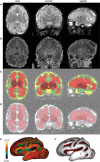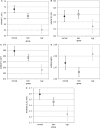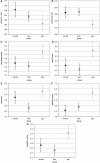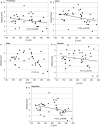Primary cortical folding in the human newborn: an early marker of later functional development
- PMID: 18587151
- PMCID: PMC2724902
- DOI: 10.1093/brain/awn137
Primary cortical folding in the human newborn: an early marker of later functional development
Abstract
In the human brain, the morphology of cortical gyri and sulci is complex and variable among individuals, and it may reflect pathological functioning with specific abnormalities observed in certain developmental and neuropsychiatric disorders. Since cortical folding occurs early during brain development, these structural abnormalities might be present long before the appearance of functional symptoms. So far, the precise mechanisms responsible for such alteration in the convolution pattern during intra-uterine or post-natal development are still poorly understood. Here we compared anatomical and functional brain development in vivo among 45 premature newborns who experienced different intra-uterine environments: 22 normal singletons, 12 twins and 11 newborns with intrauterine growth restriction (IUGR). Using magnetic resonance imaging (MRI) and dedicated post-processing tools, we investigated early disturbances in cortical formation at birth, over the developmental period critical for the emergence of convolutions (26-36 weeks of gestational age), and defined early 'endophenotypes' of sulcal development. We demonstrated that twins have a delayed but harmonious maturation, with reduced surface and sulcation index compared to singletons, whereas the gyrification of IUGR newborns is discordant to the normal developmental trajectory, with a more pronounced reduction of surface in relation to the sulcation index compared to normal newborns. Furthermore, we showed that these structural measurements of the brain at birth are predictors of infants' outcome at term equivalent age, for MRI-based cerebral volumes and neurobehavioural development evaluated with the assessment of preterm infant's behaviour (APIB).
Figures






References
-
- Als H, Lester B, Tronick E, Brazelton T. Towards a research instrument for the assessment of preterm infant's behavior (APIB) and manual for the assessment of preterm infant's behavior (APIB) In: Fitzgerald HE, Lester BM, Yogman MW, editors. Theory and research in behavioral pediatrics. New York: Plenum Publishing; 1982. pp. 35–63.
-
- Cachia A, Mangin JF, Riviere D, Kherif F, Boddaert N, Andrade A, et al. A primal sketch of the cortex mean curvature: a morphogenesis based approach to study the variability of the folding patterns. IEEE Trans Med Imaging. 2003;22:754–65. - PubMed
-
- Cachia A, Paillère-Martinot ML, Galinowski A, Januel D, de Beaurepaire R, Bellivier F, et al. Neuroimage. 2007. Cortical folding abnormalities in schizophrenia patients with resistant auditory hallucinations. DOI 10.1016/j.neuroimage.2007.08.049. - PubMed
-
- Chi JG, Dooling EC, Gilles FH. Gyral development of the human brain. Ann Neurol. 1977;1:86–93. - PubMed
Publication types
MeSH terms
Grants and funding
LinkOut - more resources
Full Text Sources
Other Literature Sources
Medical
Molecular Biology Databases

